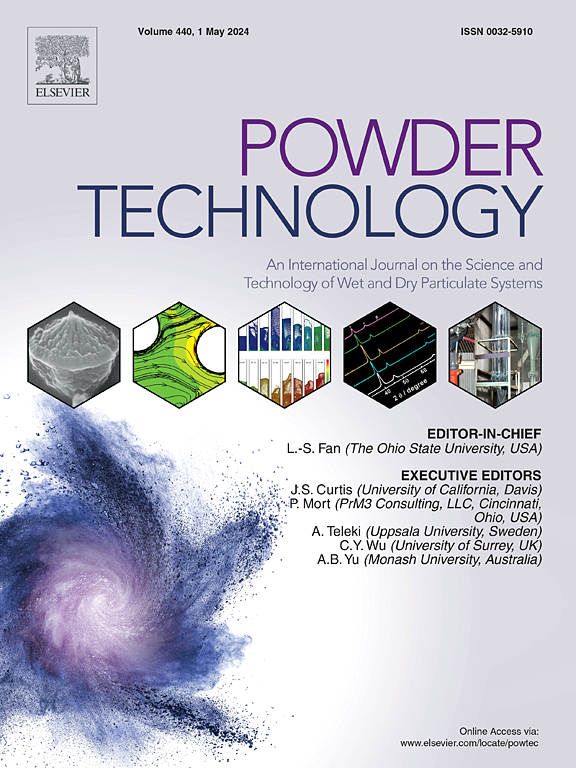Soil flow behavior in baffled rotary drum based icy lunar regolith simulant preparation
IF 4.5
2区 工程技术
Q2 ENGINEERING, CHEMICAL
引用次数: 0
Abstract
Icy lunar regolith(ILR) exists in lunar permanently shadowed regions. The preparation of ILR simulant is crucial for conducting ground-based tests for in-situ resource utilization(ISRU). To improve the fidelity of ILR, a novel method for ILR preparation was introduced, termed the water molecule deposition coating(WMDC) method, anchored in the natural formation mechanism of ILR. The cold regolith particles undergo complete tumbling, effectively trapping the water molecules. ILR samples were evaluated for uniformity in water content and micro-morphological characteristics to substantiate the effectiveness of this method. The discrete element method(DEM) was used to analyze the motion and mixing processes of lunar regolith particles within a baffled rotary drum and to determine the impact of various conditions on particle flow behaviors. The results revealed positive correlations between rotation speed, baffle number, and filling degree with central particle density (CPD), with optimal mixing index (MI) achieved at higher rotation speeds and lower filling degrees.

基于折板转鼓的冰月壤模拟制备中的土壤流动特性
冰冷的月球风化层(ILR)存在于月球永久阴影区。ILR模拟物的制备是进行原位资源利用地面试验的关键。为了提高ILR的保真度,提出了一种基于ILR自然形成机理的制备ILR的新方法——水分子沉积涂层(WMDC)方法。冷的风化层颗粒经过彻底的翻滚,有效地捕获了水分子。对ILR样品的含水量均匀性和微形态特征进行了评价,以证实该方法的有效性。采用离散元法(DEM)分析了月壤颗粒在挡板转鼓内的运动和混合过程,确定了不同条件对颗粒流动行为的影响。结果表明:转速、挡板数、填充度与中心颗粒密度(CPD)呈正相关,且转速越高、填充度越低时,混合指数(MI)越优。
本文章由计算机程序翻译,如有差异,请以英文原文为准。
求助全文
约1分钟内获得全文
求助全文
来源期刊

Powder Technology
工程技术-工程:化工
CiteScore
9.90
自引率
15.40%
发文量
1047
审稿时长
46 days
期刊介绍:
Powder Technology is an International Journal on the Science and Technology of Wet and Dry Particulate Systems. Powder Technology publishes papers on all aspects of the formation of particles and their characterisation and on the study of systems containing particulate solids. No limitation is imposed on the size of the particles, which may range from nanometre scale, as in pigments or aerosols, to that of mined or quarried materials. The following list of topics is not intended to be comprehensive, but rather to indicate typical subjects which fall within the scope of the journal's interests:
Formation and synthesis of particles by precipitation and other methods.
Modification of particles by agglomeration, coating, comminution and attrition.
Characterisation of the size, shape, surface area, pore structure and strength of particles and agglomerates (including the origins and effects of inter particle forces).
Packing, failure, flow and permeability of assemblies of particles.
Particle-particle interactions and suspension rheology.
Handling and processing operations such as slurry flow, fluidization, pneumatic conveying.
Interactions between particles and their environment, including delivery of particulate products to the body.
Applications of particle technology in production of pharmaceuticals, chemicals, foods, pigments, structural, and functional materials and in environmental and energy related matters.
For materials-oriented contributions we are looking for articles revealing the effect of particle/powder characteristics (size, morphology and composition, in that order) on material performance or functionality and, ideally, comparison to any industrial standard.
 求助内容:
求助内容: 应助结果提醒方式:
应助结果提醒方式:


